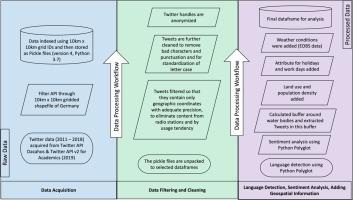Linking social media data with geospatial information to analyse changes in human sentiments in and along surface water environments
IF 1.9
Q2 MULTIDISCIPLINARY SCIENCES
引用次数: 0
Abstract
Social media data represent a valuable source of information on human activity patterns and emotional responses in relation to natural environments. These data can provide insights into the drivers of human sentiments toward freshwater ecosystems, especially in contexts where traditional survey methods are insufficient or resource intensive. A better understanding of the relationship between human sentiments and the perceived value of freshwater environments can support the integration of public perspectives into ecosystem management and regional development. In this paper, we present a replicable method for acquiring, cleaning, and analysing geolocated Twitter data from 2011 to 2018 from Germany. The method includes multiple data cleaning and filtering steps to prepare the dataset for identifying spatial and temporal trends in sentiments and to determine the primary drivers of emotional responses to water bodies. The demonstrated workflow includes the following steps:
• Geo-located Tweets were collected via the Twitter API, then sorted, indexed, and subjected to filtering and cleaning to ensure data quality.
• Language detection and sentiment analysis using a lexicon-based method (Polyglot), suitable for limited computing power, short-text social media sentiment analysis, particularly in the context of analysing the content posted by individuals spending time in freshwater ecosystems.
• Geospatial enrichment, incorporating contextual data such as weather, population density, and other location-based variables.

将社交媒体数据与地理空间信息联系起来,以分析地表水环境中人类情绪的变化
社交媒体数据代表了与自然环境有关的人类活动模式和情绪反应的宝贵信息来源。这些数据可以深入了解人类对淡水生态系统的情感驱动因素,特别是在传统调查方法不足或资源密集的情况下。更好地了解人类情感与淡水环境的感知价值之间的关系,有助于将公众观点纳入生态系统管理和区域发展。在本文中,我们提出了一种可复制的方法,用于获取、清理和分析德国2011年至2018年的地理定位Twitter数据。该方法包括多个数据清理和过滤步骤,以准备数据集,以识别情绪的时空趋势,并确定对水体的情绪反应的主要驱动因素。演示的工作流程包括以下步骤:•通过Twitter API收集地理位置的tweet,然后进行排序,索引,并进行过滤和清理以确保数据质量。•使用基于词典的方法(Polyglot)进行语言检测和情感分析,适用于有限的计算能力,短文本社交媒体情感分析,特别是在分析个人在淡水生态系统中花费时间发布的内容的背景下。•地理空间丰富,结合上下文数据,如天气、人口密度和其他基于位置的变量。
本文章由计算机程序翻译,如有差异,请以英文原文为准。
求助全文
约1分钟内获得全文
求助全文
来源期刊

MethodsX
Health Professions-Medical Laboratory Technology
CiteScore
3.60
自引率
5.30%
发文量
314
审稿时长
7 weeks
期刊介绍:
 求助内容:
求助内容: 应助结果提醒方式:
应助结果提醒方式:


